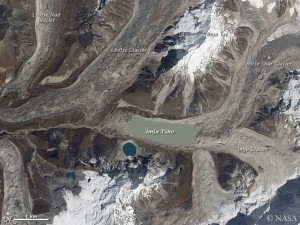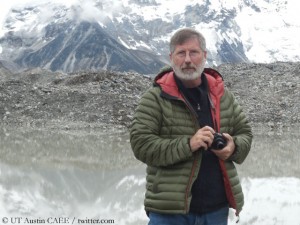Time bomb Imja Tsho defused – for now
It’s like handling a water butt. The amount of rainfall is not manageable. If you want to prevent the butt from overflowing, you must drain the water. According to this model, the water level of Imja Tsho has now been lowered by a total of 3.40 meters over a period of two months. The glacial lake in the Everest region, which is almost 150 meters deep in some places, has steadily expanded over the last few years as a result of climate change, and has become a threat to the downstream villages, especially the nearby located Chukhung and Dingboche. A bursting of the natural dam at an altitude of about 5,000 meters could have devastating consequences. Soldiers from the Nepalese army were involved in the construction work for the canal, via which a total of four billion liters of water were drained. According to the government in Kathmandu, “an estimated 96,562 people, including tourists” – for this exact estimate Nepal earns an entry in the Guinness Book of Records 😉 – are expected to benefit from the project, which cost about three million US dollars and was funded by the United Nations. Daene McKinney, professor of Environmental and Water Resources Engineering at the University of Texas at Austin, was on site and has replied to my questions.
Professor McKinney, you were involved in the Imja Lake lowering project in the Everest region. How dangerous did you assess the situation before starting to drain the water?
We have been researching this question of the risk of Imja Lake for a number of years now. This work has involved field observations and measurements, community consultations and detailed computer modeling. Our most recent publication on this, Rounce et al. (2016), notes that the risk of the lake is “moderate”. This categorization is based on both the current status of “low” hazard of the lake and future hazard status of “very high” due to the continued expansion of the lake that will result in the possibility of avalanches falling into the lake in the future (but not at the present time).
Do you think the situation is now under control?
The recent lowering of the lake by 3-3.5 m has certainly reduced hydrostatic pressure from the lake on the terminal moraine to some extent and this helps. However, the lake continues to expand and in the future, the situation will become a problem. In addition, the small lakes that make up the outlet channel of the lake continue to deteriorate and coalesce into the main body of the lake due to the ice-cored nature of the moraine. This will act to increase pressure on the moraine and increase the risk to some extent.
The Nepalese government talked about a “milestone adaption work not only for Nepal but across globally”. It was a pilot project. How realistic is it to transfer the Imja model to other potentially dangerous glacier lakes?
The construction experience of Imja is of great value to the region, demonstrating the ability to perform such work at high altitude remote locations. However, the design criteria for lowering the lake (lower the lake at least 3 m) were arbitrarily selected with no scientific or engineering basis. This was similar to the situation at Tsho Rolpa (in the Rolwaling Valley), the only other lake that has been lowered n Nepal. It is hoped that when considering the design of lake lowering systems for other lakes in Nepal, e.g. Thulagi Lake (located near the eight-thousander Manaslu), that a more systematic and scientific method will be used to decide of the “safe” lake level.
It is to be expected, that climate change will cause more glacial lakes in the Himalayas or aggravate the situation at already existing lakes. Do you think the problem can be handled?
Definitely, more lakes are appearing and expanding every year in the Himalayas and this will continue for the foreseeable future. Some of these will turn out to pose risk to downstream communities and infrastructure. The level of risk posed by these lakes must be assessed (something that we are working on now) and acceptable risk levels must be determined to protect downstream people and assets. In cases where the risk is too high, new lake safety systems must be properly designed and implemented.










